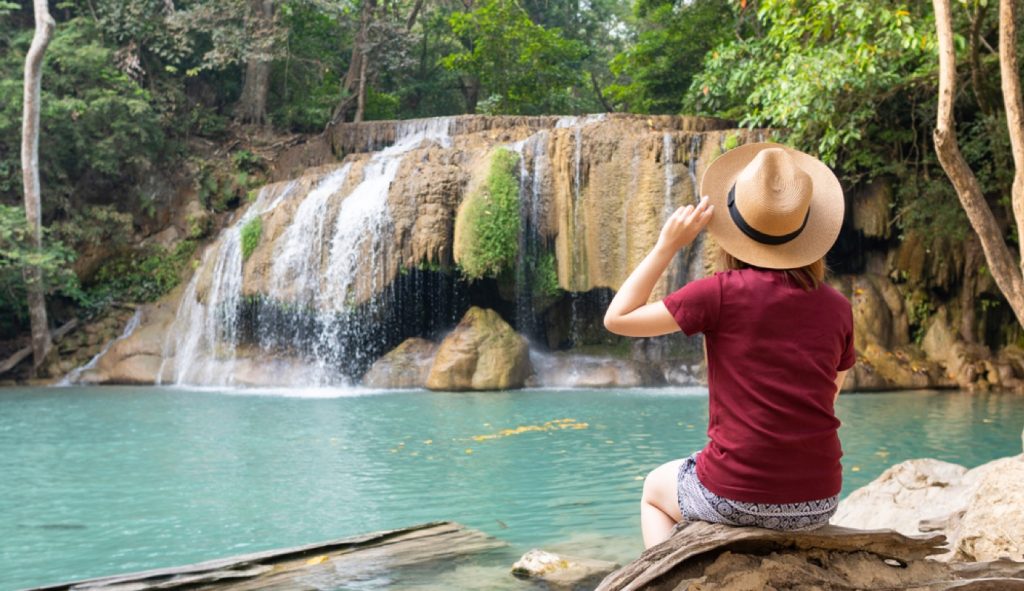
Kanchanaburi, Thailand, is a world of green hills, majestic waterfalls and sprawling national parks. However, it is also the final resting place of many brave soldiers who fought in World War II. Unlike other cities in Thailand, Kanchanaburi is the type of place where travelers are encouraged to go on trips of discovery and reflection as many sites take you on a journey down the grim history of the area.
Along with history, Kanchanaburi is also the place to be for travellers who are looking for a slower pace than Bangkok. Its rivers, caves and waters are all within reach of the big city and offer a haven for those who are tired of the city traffic.
Kanchanaburi, Thailand, has three distinct seasons: the hot season, the cool season (peak season) and the wet season (low season). Despite the three distinct seasons, the average monthly temperatures in Kanchanaburi vary very little all year. However, the area is less temperate than other tourist destinations worldwide.
From July through October, tourists who visit Kanchanaburi should be prepared to face intense rains that last less than a couple of hours. The average temperature during these months is 86 degrees, with the temperature going down to 83 degrees in October.
Nov
32°C
Avg.Rain
9mm
Dec
32°C
Avg.Rain
15mm
Jan
34°C
Avg.Rain
10mm
Feb
35°C
Avg.Rain
50mm
The cool season lasts from November through January. During this season, Kanchanaburi weather averages at 77 degrees. This is also the peak season for tourists. This means Kanchanaburi attractions like the Erawan National Park, Kanchanaburi War Cemetery and Tiger Temple see an influx of visitors.
Mar
32°C
Avg.Rain
9mm
Apr
32°C
Avg.Rain
9mm
May
32°C
Avg.Rain
10mm
Summers in Kanchanaburi is very hot. Generally, mid-April sees the highest temperatures, rarely dropping below 100. During these months, visiting Kanchanaburi and its tourist attractions can become undesirable.
Jun
32°C
Avg.Rain
9mm
Jul
32°C
Avg.Rain
15mm
Aug
34°C
Avg.Rain
10mm
Sep
34°C
Avg.Rain
10mm
Oct
34°C
Avg.Rain
10mm
The cool season is also the peak season in Kanchanaburi. This means the prices for accommodations, activities and flights are likely to be the highest during this season. Despite that, the pleasant weather makes November to January the best months to fly in for people hoping to go around the city without worrying about a rainstorm or the battering heat.
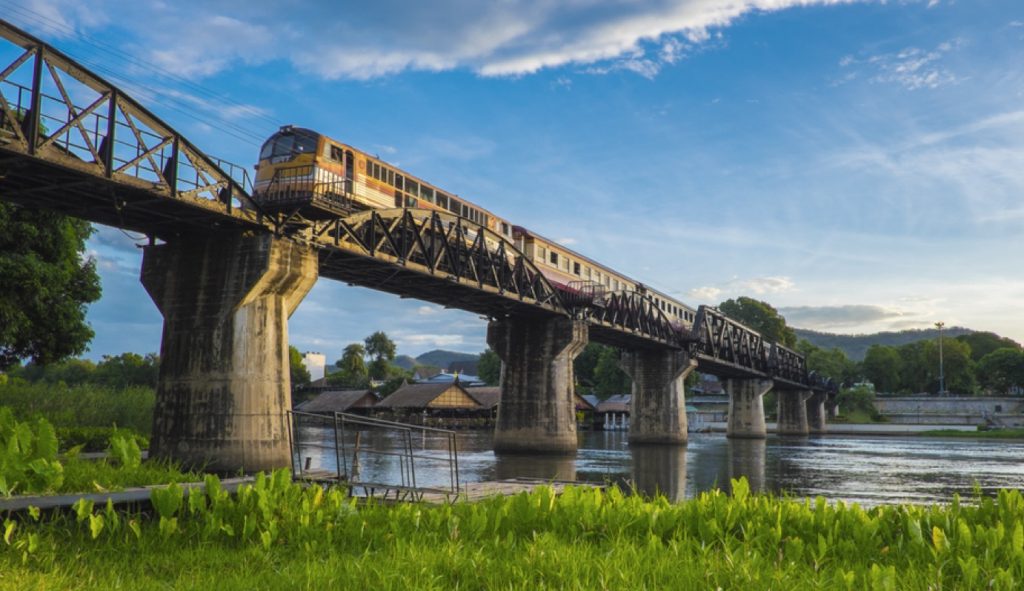
Key events:
Loy Krathong Festival, where locals set banana leaves and other home-made boats at the river Kwai to thank Buddha
River Kwai Bridge Week, commemorates the sacrifices of the men who built the Death Railway.
During the monsoon season, the prices of accommodations, activities and flights are at their lowest. Therefore, these months are the best time to visit Kanchanaburi if you want to save up money for the trip. However, it is advised to prepare for heavy rains during the monsoon months.
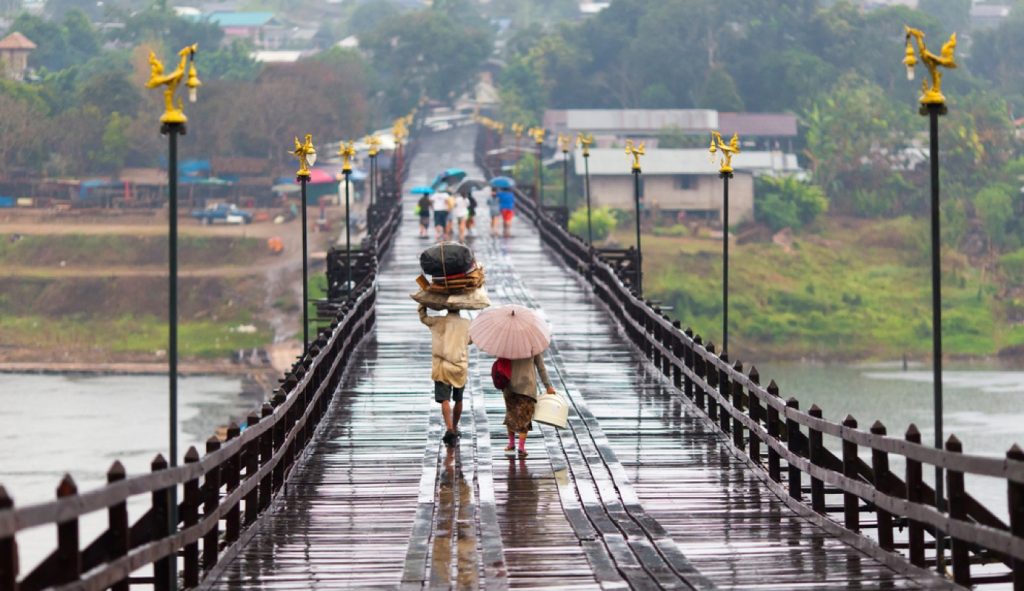
Key events:
Longboat Race, where teams of locals race against each other in a rowing competition.
Tak Bat Devo, a Buddhist festival celebrated annually in the country’s central region
Kanchanaburi is a quaint town. However, it is rich in history and stories, some of which have inspired some of the most heartbreaking books and films. The city is known for many attractions, particularly the River Kwai Bridge, Death Railway, Thailand Burma Railway Centre, Erawan National Park and World War II-related museums.
Many places in Thailand are best reached by taking a flight into the capital city of Bangkok. That being said, Kanchanaburi is not one of them as it does not have its own airport. Located just 126 kilometres (78 miles) from the capital, the quaint, laid back town is best reached by road or train.
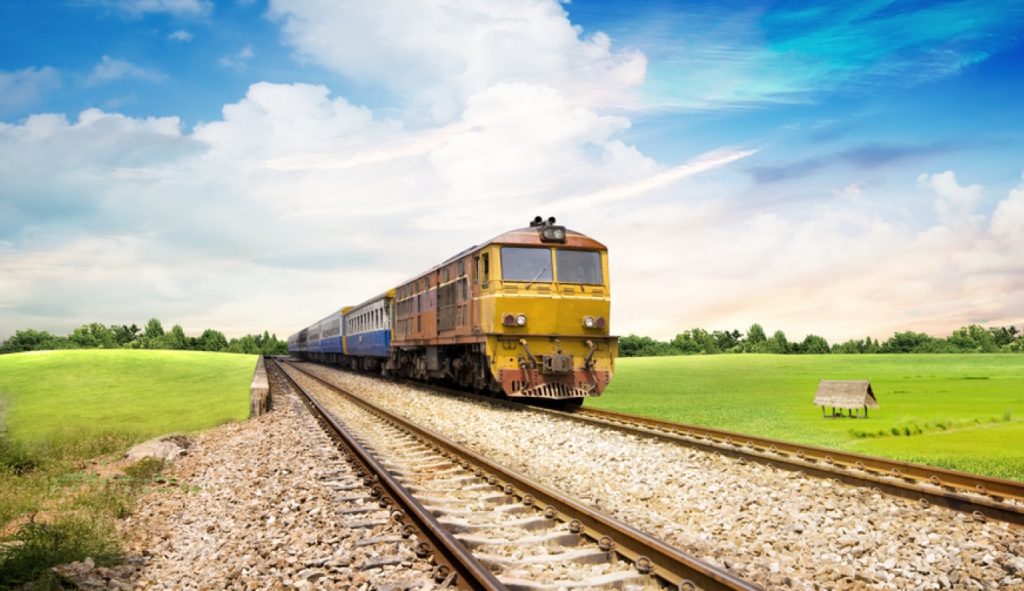
Travelling by train from Bangkok to Kanchanaburi is, by no means, the quickest or the most comfortable way. However, it is incredibly popular among tourists who want to see the urban area of the Thai capital when they leave Bangkok.
Trains from Bangkok to Kanchanaburi depart at 7:50 a.m. and 1:55 p.m. from Thonburi Train Station (Bangkok Noi). The Thonburi station is located near the Chao Phraya River and river ferry piers Wang Lang Pier and Thonburi Railway Pier.
A train journey from Bangkok to the main train station in Kanchanaburi costs 100 THB. There is no need to book a Kanchanaburi train ticket in advance.
Buses from Bangkok to Kanchanaburi leave from various locations, including the Southern Bus Terminal in Sai Tai Mai, the Northern Bus Terminal in Mo Chit, and Khao San Road. Regular buses depart regularly throughout the day from 4 p.m. to 10 p.m. The bus would bring you directly to the Kanchanaburi bus terminal, located near markets and shopping centres north of Sangchuto Road.
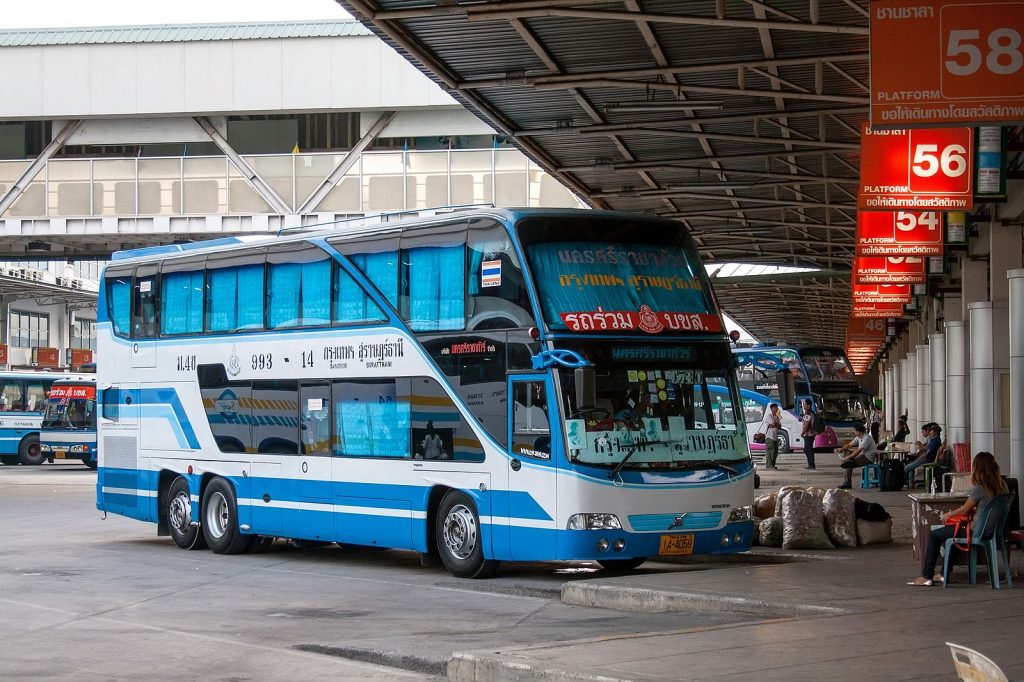
There are two types of buses offered in the Southern and Northern Bus Terminals: first class and second class.
A first-class bus gives tourists more comfort as it is equipped with a toilet and air conditioning. Generally, first-class bus tickets may cost 120 Thai Baht (THB) per person.
While it does not have a toilet, a second class bus also has air conditioning and is as comfortable as its counterpart. Tickets for regular buses cost 80 THB per person.
Journey times vary. However, the trip from Bangkok to Kanchanaburi bus station takes three to four hours, depending on the route the bus takes.
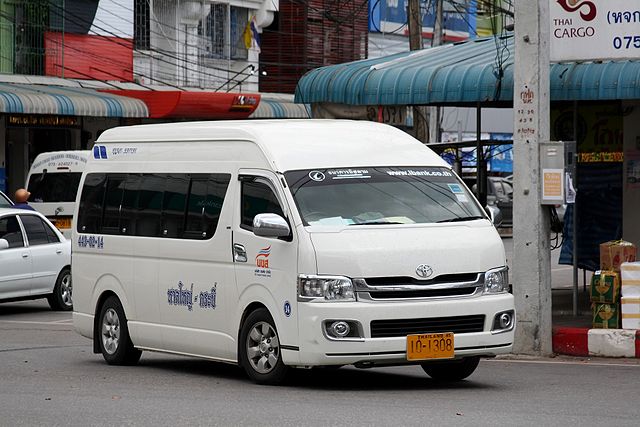
Many tourist minibuses are operating between Bangkok and Kanchanaburi. There are two ways for you to book a minibus: through a travel agency along Khao San Road or your hotel.
Here are some of the best minibus services you should get if you plan to visit Kanchanaburi:
Minibuses operated by Win Happy can take you from the southern bus terminal in Bangkok to Kanchanaburi bus terminal on U-Thong Soi 6 Road. The minibuses depart from 6 a.m. to 6 p.m. daily, with each ticket costing 150 THB.
Win Happy introduced a new fleet of minibuses in 2019 that has improved seats and air conditioning. In total, a minibus can seat at least 20 people.
Minibuses operated by Monsiri Travel depart Mochit New Van Terminal at least six times per day. The first trip leaves at 6 a.m. The last bus departs the station around 5 p.m.
Ticket prices for the minibus cost 135 THB. The minibus seats around eight people. However, you may book an extra seat if you have a large amount of luggage.
Minibus operator Mama Travel operates from Khao San Road, with buses departing three times a day from 7 a.m. to 3 p.m. Each minibus can seat up to 8 passengers. Again, you can book an additional seat if you have any extra luggage. A ticket for the minibus will cost you 289 THB.
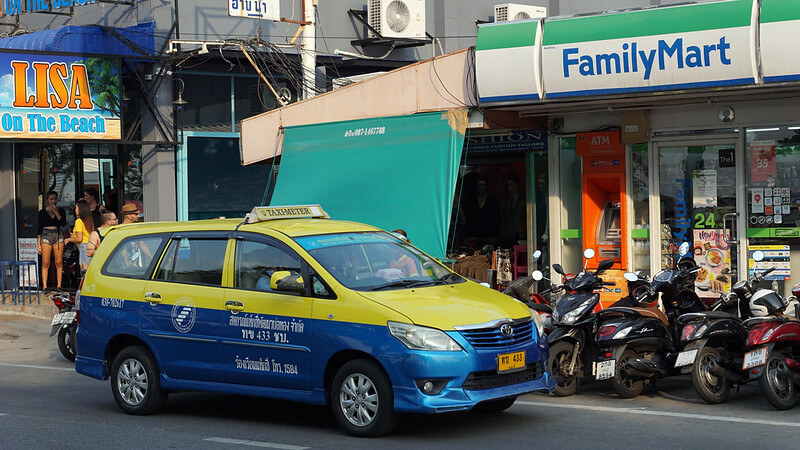
Travelling to Kanchanaburi by private taxi is the easiest and fastest way there is to get there. However, it is also the most expensive.
Getting a private taxi may cost you around 3000 THB, but it may be the best option if you travel in a group or with family.
Kanchanaburi, Thailand, is a fairly small city. With that being said, Kanchanaburi is still a little too stretched to walk around comfortably. Many of the best tourist attractions, such as the Death Railway, River Kwai, Erawan National Park and Kanchanaburi War Cemetery, are located in the centre or outside the city.
There are many modes of transportation available in Kanchanaburi.
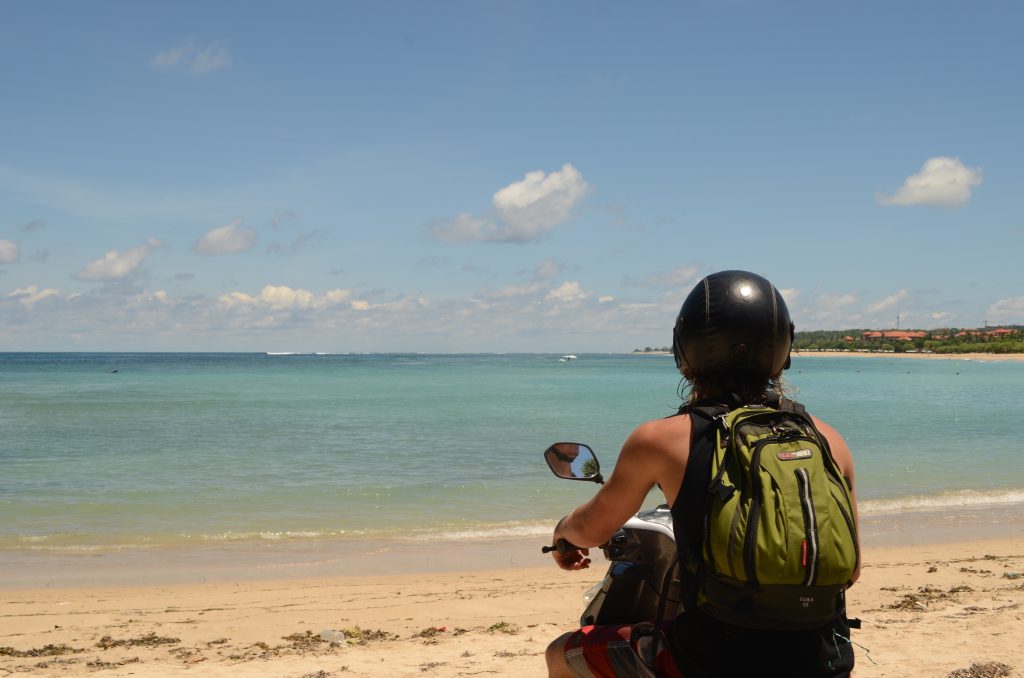
If you are confident in your skills to ride a motorcycle, renting your own scooter may be the best option. Motorbike rentals are incredibly cheap, with prices starting as little as 150 THB per day for older models.
If you wish to rent a motorcycle, do consider that many rental shops neglect to maintain their bikes. It is advised that you check the bike over before you pay for rent. Additionally, it is also that you take photos of the motorcycle prior to signing the contract. If you see any damages before the ride, make sure you notify the renter. This prevents them from charging you extra for any damages on the motorcycle, even if you did not cause it.
Also, bear in mind that roads in Thailand are not so well maintained. So be on the lookout for potholes or cracked pavement during your travels.
Motorbike taxi or motorcycle taxi is one of the cheapest and quickest public transport options in Kanchanaburi. However, it can also be one of the most dangerous ways of getting around the city as motorbike taxis weave in and out of stationary traffic at high speed.
Most tourists looking to save money in travelling will be delighted to learn that fares for motorcycle taxis start from as little as 30 THB.
If you feel athletic or looking for a cheap rental, a bicycle could be a perfect choice. Rental shops charge as little as 50 THB per day.
However, if you plan to head out of the city, bicycles may not be a great option as it gets really hot and humid in the countryside.

Taxis are the most comfortable and convenient way of getting around Kanchanaburi province. However, many drivers refuse to use their meter and try to haggle on a price before the trip. The price will often be double or even triple the meter fare.
The best way to get a taxi at a reasonable price is to hail one using the Grab app. This allows you to agree on the route during the trip and prevents drivers from charging you for more.
Much like everywhere else in Thailand, tuk-tuks are expensive novelty rides that only appeal to visitors. Drivers of tuk-tuks offer steep prices in hopes you would not haggle. Additionally, most drivers do not speak English.
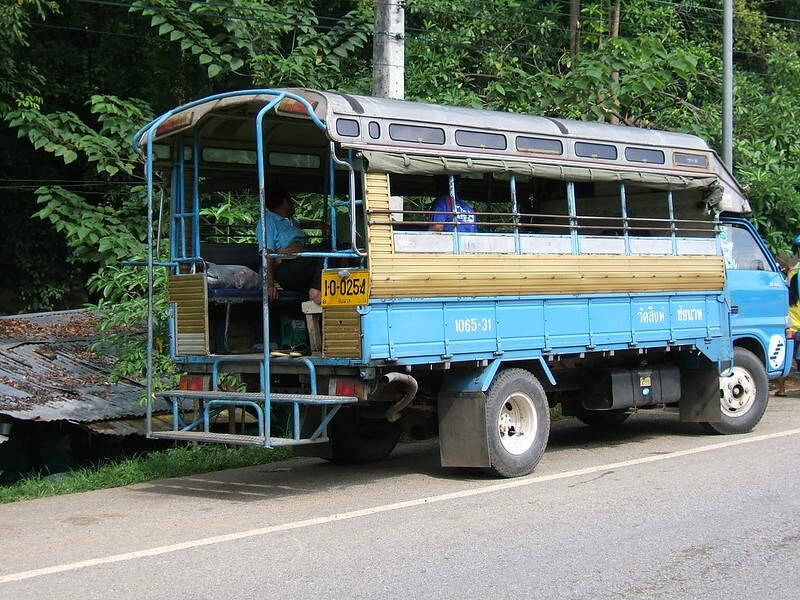
Songthaews are converted pickups that function similarly to communal taxis. This type of transportation travels on a fixed route.
Short trips on songthaews cost 10 THB. However, the driver of an empty songthaew may be willing to drive you directly to your destination for a fixed price.
While songthaews are convenient, it may be difficult if you do not understand Thai or if you do not have a map.
Kanchanaburi is an otherwise unassuming Thai town. However, it is famous for offering tourists two different atmospheres. The city was once invaded by the Japanese Army in World War II and became the starting point for the brutal Death Railway.
Today, Kanchanaburi is dotted with places where locals and tourists alike can learn more about its dark history. These places include the Death Railway Museum and the Kanchanaburi Railway Station. It is also home to the Erawan National Park, which is a beautiful lush area where tourists can go bamboo rafting or ride down the River Kwai on a floating raft.
Jump to location
The northern side of the Mae Nam Khwae Road is home to plenty of restaurants, travel agencies and museums. However, despite having a range of tourist attractions, the neighbourhood is well removed from the loud nightlife found in the south.
The district offers a wide range of accommodation options, from a contemporary lodge style resort to an eco-luxury resort with air conditioning and an outdoor pool. It also gives tourists the chance to visit the famous River Kwai Bridge (Death Railway Bridge).
The northern side of the Mae Nam Khwae Road is at least five kilometres from the old town, Kanchanaburi War Cemetery and the local bus station.
Unlike the northern side of the Mae Nam Khwae Road, the south is packed to the brim with a collection of hotels in Kanchanaburi, Thailand. Each hotel is also located a walking distance from a strip of bars and local eateries.
Most hotels in this Kanchanaburi town are located riverside. Guests have a wide range of accommodation options, from those that offer a private balcony to air-conditioned rooms with private bathrooms and a private pool.
The southern side is known for being a party hub. While local officials have banned live music after midnight, late-night noise may still cause an issue for people who turn in earlier.
If you are looking for a hotel in Kanchanaburi that does not cost much, the options along the west of the River Kwai may be the best choice. The neighbourhood offers deluxe rooms for flashpackers and travellers on a budget. It’s also located not far from tourist destinations.
The west of the river is located near the nightlife strip across the city’s Sud Jai Bridge. While you are bound to get a quiet night’s sleep, you may need to book a guest house ahead of your trip. As accommodation prices are affordable, the slots for modern rooms fill up fast.
Ronghaebaoy Road is peppered with old-style guesthouses and flashpacker accommodations. Some of the hotel options in the area feature a buffet breakfast and an outdoor swimming pool. The neighbourhood is also home to a few floating hotels.
The neighbourhood is best for tourists hoping to visit the Jeath War Museum or explore the Mae Nam Khwae Road while staying in a secluded natural area.
Rongheabaoy Road is very narrow. It’s also strategically located between the old town and some of the best tourist spots in the city. This means the rooms may fill up quicker than those in other districts.
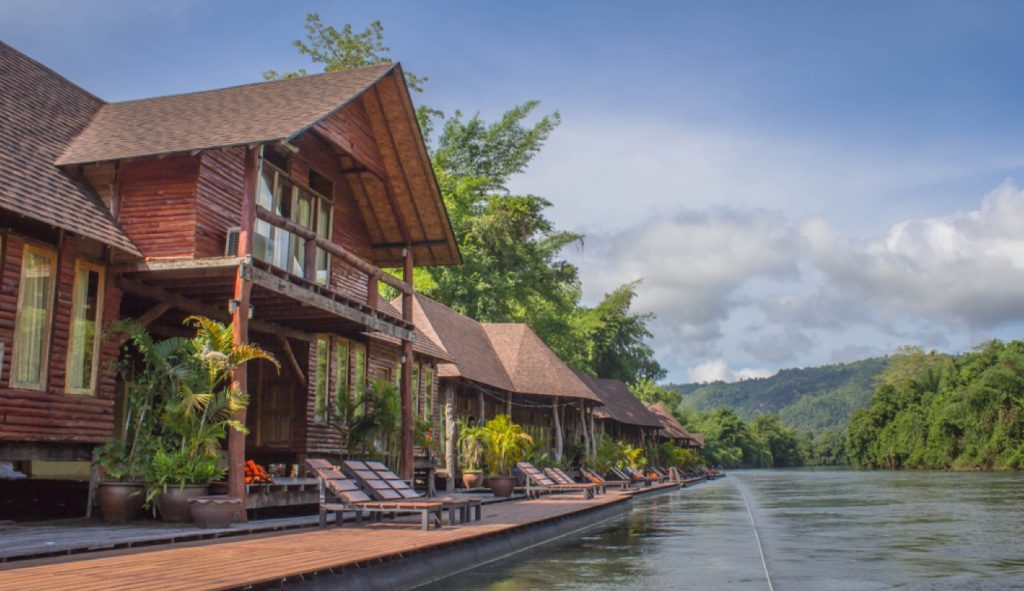
Sai Yok is a town located further northwest of the city. The area is home to accommodations with prices that are generally cheaper than those found in the city itself. The district is also near several tourist spots, including the famous Hellfire Pass and the Prasat Muang Singh temple.
Sai Yok is a fairly rural area that you can only access if you hire some transport.
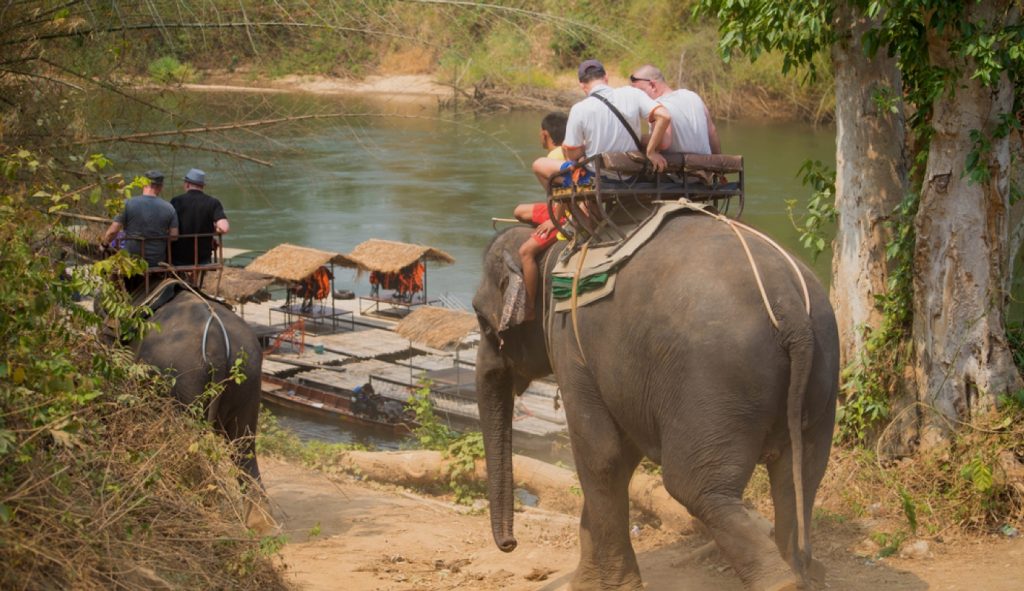
Located in the northwest of the city centre, Wang Dong is famous for its beautiful scenery and close distance to the Elephant World— a tourist spot where families can care for rescued elephants through a number of on-site activities.
Wang Dong is a fairly rural area. As such, there are only a few high-end resorts in the neighbourhood.
The city of Kanchanaburi is one of the several Thai cities that makes the country a truly fascinating place to visit. Besides having magnificent landscapes, Kanchanaburi is also rich in history, especially from the World War II era. Today, the city is dotted with memorials and museums that talk about some of the most controversial events in Thai history.
Nature lovers will also find plenty of things to do in Kanchanaburi. There are several national parks in the area as well as animal sanctuaries. Additionally, there are many opportunities to see stunning waterfalls and cave systems.
In 1942, during the second world war, Kanchanaburi fell under the control of the Japanese. It was at this time that the Japanese forced labourers and prisoners of war to build several infamous places en route to invade Malaya (Malaysia and Singapore), as well as Burma (Myanmar). Many of the structures still stand today, having been turned into tourist attractions where locals and tourists alike can learn about the war. Here are some of the places you cannot miss when in Kanchanaburi:
Kanchanaburi, Thailand’s natural surroundings offer a soothing counterpoint to its emotionally charged attractions. The city is also home to some of the most picturesque views, most beautiful national parks and sanctuaries for elephants who have been used for some form of abusive work in the past.
Best nature spots to go to:
Much like the rest of Thailand, people in Kanchanaburi also take pride in their religious culture, marked by the numerous towering temples dotting the city. The temples across the city come in different ranges of colours and are made of different materials. Here’s a list of the best temples to visit in Kanchanaburi:
Kanchanaburi is a historic Thai city that was once occupied by the Japanese during World War II. Today, tourists who visit Kanchanaburi are treated to a range of museums depicting the dark history of the region and the steps its people took to rise above the challenge.
If you’re looking to save some money, you should visit Kanchanaburi’s street food stalls. The vendors of these quaint stalls serve some of the best food in the region for dishes that only cost around 30 THB. While comically small, most vendors set up a couple of plastic tables and chairs where you can sit comfortably while eating.
Like most places in Thailand, Kanchanaburi is very safe. However, some parts of the city, especially those in the rural areas, are poorly lit at night. If you are unsure of where you’re going, it may be best to book a taxi ride.
Erawan National Park – River Kwai Bridge – Death Railway Bridge – Sai Yok National Park – Kanchanaburi War Cemetery – Thailand Burma Railway Centre – Jeath War Museum – allied War Cemetery – Tiger Temple – Wat Tham Khiritham – Hellfire Pass Memorial Museum – Elephant Sanctuaries – World War II Museum – Bridge War Museum
Book a day trip to the famous Erawan National Park – Visit the ancient Prasat Muang Singh Historical Park – Take Thai Cooking Classes and learn to cook authentic Pad Thai – Buy affordable handmade souvenirs at the night market (Also known as the River Kwai Park Market) – Travel Back In Time at Mallika City
Royal River Kwai Resort – Glory River Kwai Hotel – ComSaed River Kwai Resort – Thailand Natee The Riverfront Hotel Kanchanaburi – The Bridge Residence Hotel – The Vista Pool Villa – U Inchantree Kanchanaburi – The Siamese Living Heritage Town – Dheva Mantra Resort